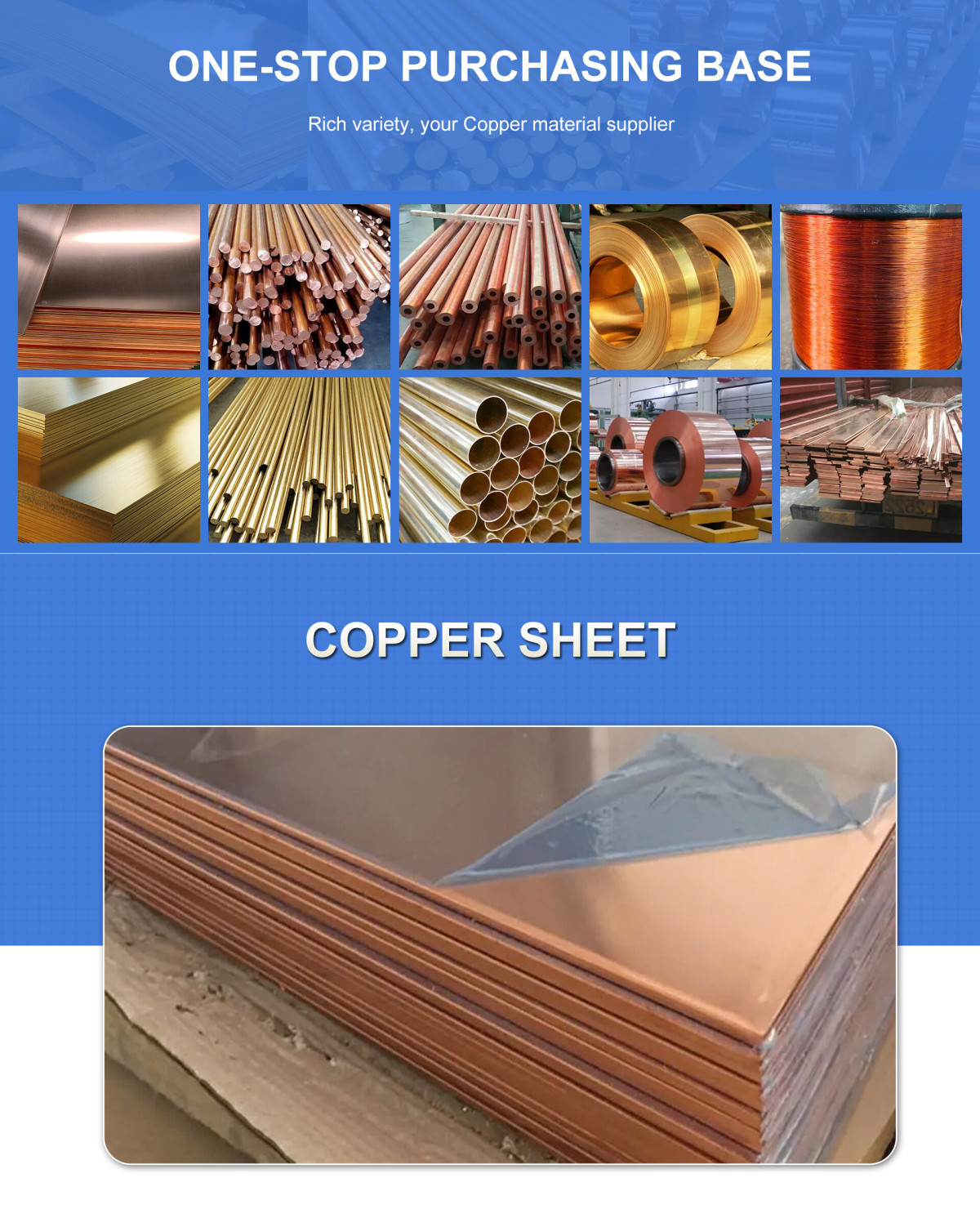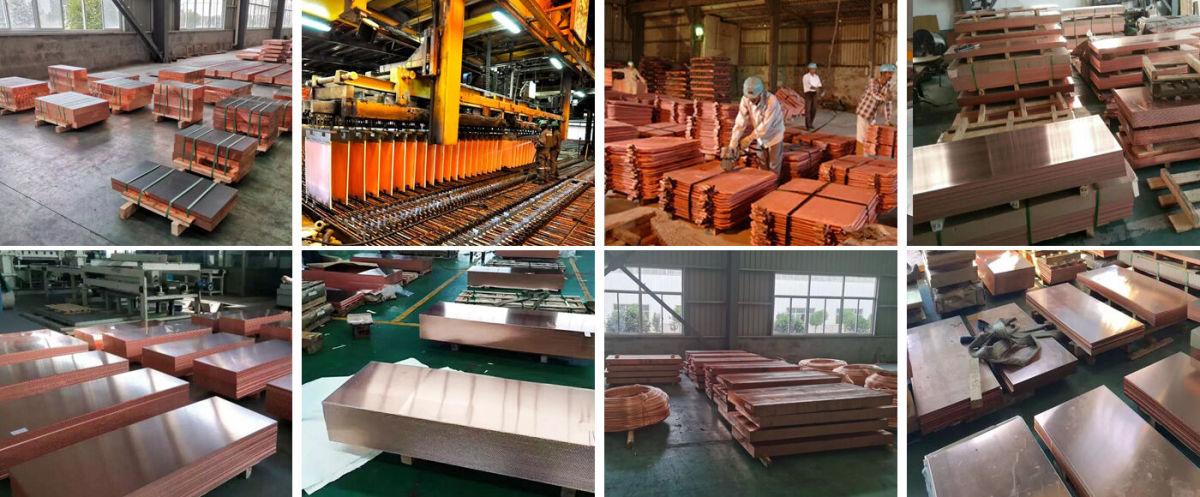
C63000 Copper Plate Dimensions (Sheet/Plate Form)
C63000 plates are available in a wide range of dimensions to accommodate industrial requirements. The following specifications are standardized for sheet/plate forms:
Notes:
- Custom dimensions (e.g., non-standard thickness, width, or length) are often available upon request.
Thinner sheets (0.01–6 mm) are typically cold-rolled, while thicker plates (2–200 mm) are hot-rolled or forged.
International Standards for C63000 Copper Plate
C63000 is governed by several international standards to ensure material consistency and performance. Key standards specific to plate/sheet forms:
ASTM B150/B150M:
- Specifies requirements for copper alloy plates, sheets, strips, and rolled bars.
- Covers chemical composition, mechanical properties (e.g., tensile strength ≥ 690 MPa, yield strength ≥ 345 MPa), and testing protocols.
ASME SB-171:
- Applies to copper-alloy plates and sheets for pressure vessels, condensers, and heat exchangers.
MIL-B-16033:
- Covers nickel aluminum bronze plates for marine applications, including propeller blades and structural components.
EN 12420 (CuAl10Ni5Fe4):
- European standard for nickel aluminum bronze plates, equivalent to C63000.
Additional Standards (General Material Compliance):
- AMS 4640: Aerospace Material Specification for nickel aluminum bronze.
- SAE J461/J463: Defines mechanical and chemical requirements for automotive and industrial applications.
Detailed Chemical Composition of C63000 Copper
C63000 (UNS C63000) is a nickel-aluminum bronze alloy with a complex chemical composition designed for high strength and corrosion resistance. The chemical composition ranges are as follows :
Key Notes:
- The alloy is primarily copper-based, with aluminum and nickel as critical strengthening elements.
- Trace elements like Pb, Zn, and Sn are tightly controlled to avoid compromising mechanical properties
Mechanical Properties of C63000 Copper
C63000 exhibits excellent mechanical performance, particularly in high-stress and corrosive environments. Below are the key mechanical properties based on ASTM B150 and other standards :
1. Tensile and Yield Strength
2. Ductility and Hardness
3. Elastic and Thermal Properties
4. Fabrication and Processing
- Machinability: 30% (relative to free-cutting brass UNS C36000)
- Hot Working: Good formability at 788–927°C (1450–1700°F)
- Cold Working: Poor; not recommended for severe cold-forming operations
- Annealing: Performed at 593–704°C (1100–1300°F) to relieve stresses

Production process and product advantages of C63000 copper plate:
1. Production process
Hot working
The hot working temperature range is 850-900℃, and plastic deformation and forming are achieved through hot forging, hot rolling or hot extrusion. The material after hot working has good high-temperature plasticity and uniformity of structure.
Cold working
Cold working is carried out at room temperature and is suitable for manufacturing high-precision parts, but due to the characteristics of rapid work hardening of the material, the application of cold working is limited.
Heat treatment
The hardness and mechanical properties can be significantly improved by quenching and tempering processes. For example, after heat treatment, the material can form α phase and κIII phase, further improving wear resistance and high temperature stability.
Forming process
Casting: Suitable for complex shape parts such as pump bodies and valves.
Welding: Supports argon arc welding and resistance welding (spot welding, flash welding), but gas welding needs to adjust the flame to non-oxidizing to avoid oxidation.
Machining: It has good cutting performance (cutting efficiency 20-30%) and is suitable for manufacturing precision gears, bushings, etc.
2. Product advantages
Excellent mechanical properties
Tensile strength can reach 540-790 MPa, yield strength 240-390 MPa, hardness ≥180 HB, suitable for high stress parts such as bearings and gears.
Corrosion resistance
Excellent performance in the atmosphere, fresh water and seawater, resistant to alkali and non-oxidizing acids (such as phosphoric acid and acetic acid), suitable for marine engineering such as ship propellers and valves.
Wear resistance
Contains iron and manganese elements to improve wear resistance, widely used in easily worn parts such as screws and sealing rings.
Excellent thermal performance
Thermal conductivity is 39-77.13 W/m·K, melting point is 1040-1093℃, suitable for heat exchangers and high-temperature mold materials.
Special functions
Spark-free characteristics: used for explosion-proof tools.
Shape memory effect: expanded to the field of smart materials.
Economical
Compared with materials such as tin bronze and stainless steel, it has more cost advantages and can replace high-priced alloys.
Q1:Do you provide samples? Is it free or extra?
A1:Yes, we can provide samples free of charge and the customer will pay the freight.
Q2:What if I don't have export experience ?
A2:We have reliable forwarder agent which can ship items to you by sea/air/Express to your doorstep. Any way, we will help you choose the most suitable shipping service.
Q3:How long is your lead time?
A3:If it is in stock, it is usually 5-10 days. Or, if there is no inventory, 15 days, depending on the quantity.
Q4:What are your terms of payment?
A4:30% T/T deposit in advance, 70% T/T balance within 5 days after B/L copy, 100%.Irrevocable L/C at sight, 100% Irrevocable L/C after receive B/L 30-120 days, O/A.
Q5:How is your technical support?
A5:We provide lifetime online support through Whatsapp/ Skype/ Wechat/ Email. Any problem after delivery, we will offer you call anytime.
Welcome To Your Inquiry
What can we help you?
RELATED PRODUCTS












